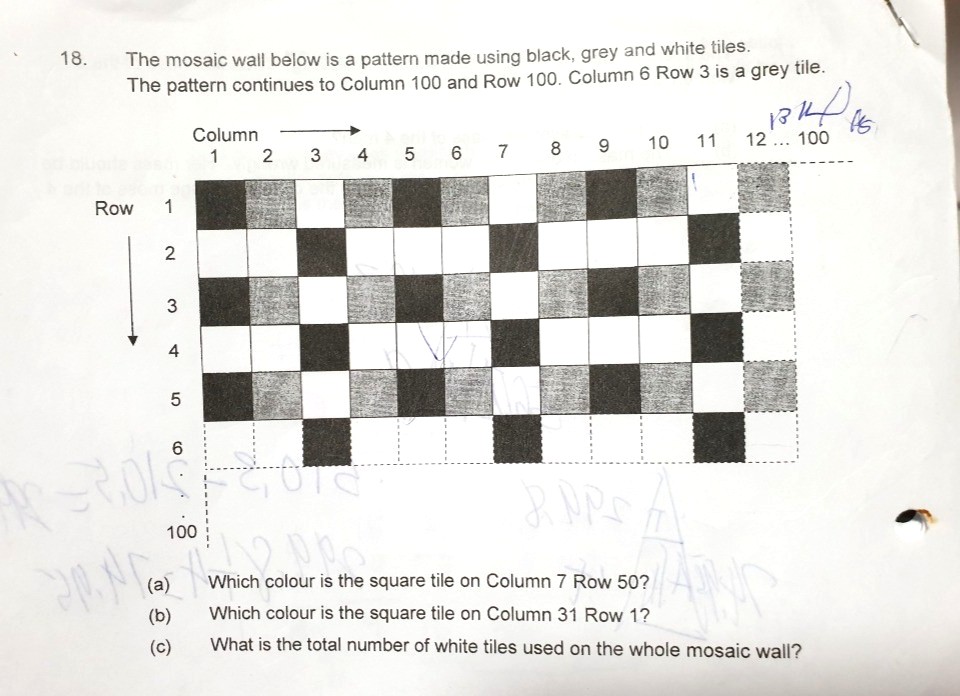Ask Singapore Homework?
Upload a photo of a Singapore homework and someone will email you the solution for free.

Question
primary 5 | Maths
| Whole Numbers
One Answer Below
Anyone can contribute an answer, even non-tutors.

Does anyone know how to solve this? Thx
You will eventually realise that the fifth column is the same as the first column, and the ninth column is the same as the fifth column. Upon closer inspection, we see that the pattern repeats itself every 4 columns.
Similarly, the pattern repeats itself along the rows as well every 2 rows.
Since 50 divided by 2 leaves no remainder at all (this is to be treated as a "remainder of 2" for this question), the tiles in Row 50 would have the same series of tiles as Row 2.
So, the square tile on Column 7 Row 50 will have the same coloured square tile on Column 7 Row 2, which is black.
So, the square tile on Column 31 Row 1 will have the same coloured square tile on Column 3 Row 1, which is white.
So, there are 4 white tiles for every 8 tiles present, or half of the tiles are white.
The "100" in Column 100 Row 100 is exactly divisible by both 4 and 2, so we would nicely be able to cut the tiles up into 4 by 2 as per described above.
Since there is no remaining tiles, there must exactly be half of the tiles being white.
Total number of tiles
= 100 x 100
= 10000
Total number of white tiles
= 10000 divided by 2
= 5000
Every column is made up of alternating white and coloured tiles according to the following pattern :
black,white,black,white..
grey,white,grey,white..
white,black,white,black..
What we want to do is to pair up every 2 squares in a column from the start to end.
Every pair has 1 coloured and 1 white square. (equal numbers)
Number of white is half of a pair.
For every column, there are 100 squares.(since 100 rows are present)
100 squares ÷ 2 squares per pair = 50 pairs
There are exactly 50 pairs, so in each column there are 50 white squares.
Since there are 100 columns in total,
100 columns x 50 white squares per column = 5000 white squares in total
Look at Column 7 first. The white and black tiles are alternating.
For even row number : black
For odd row number : white
Since Row 50 is an even row number, the square is black.
When we look at Row 1,
The pattern repeats every 4 squares or columns.
(Black, Grey, White, Black)
For Column 31, it is right before Column 32.
We know that 32 is a multiple of 4.
(32 ÷ 4 = 8)
So Row 1, Column 32 has the same square colour as the Row 1, Column 4. It is black.
(Or you can see it as 4,8,12,16,20,24,28,32)
Since Column 31 is the one before it, the square has to be white for Row 1 Column 32.
See 1 Answer
You can observe that column 7 it’s all alternating black tiles, what is different is the row numbers. Interestingly if you observe the even row numbers (2,4,6, etc) it is black tile. Odd row numbers are white tiles. So since 50 is an even number, the pattern follows a black tile
b) white tile
using the column pattern: 3,7, 11,15,19,23,37, 31, 35, etc.
We find column 31 in this list. So the pattens is that of part a, where we look at row numbers to determine the colour. Since row 1(odd)= white
C) total number of tiles = 100x100 = 10,000
Use pattern 6x6 in diagram as a guide. We can count that there are altogether 18 white tiles in (6x6)=36 tiles. Therefore, in column 100 and row 100, There are half the number of white tiles. 10,000/2 = 5000
Hope my explanations above is clear. I used observation and some simple pattern to find the answers.





